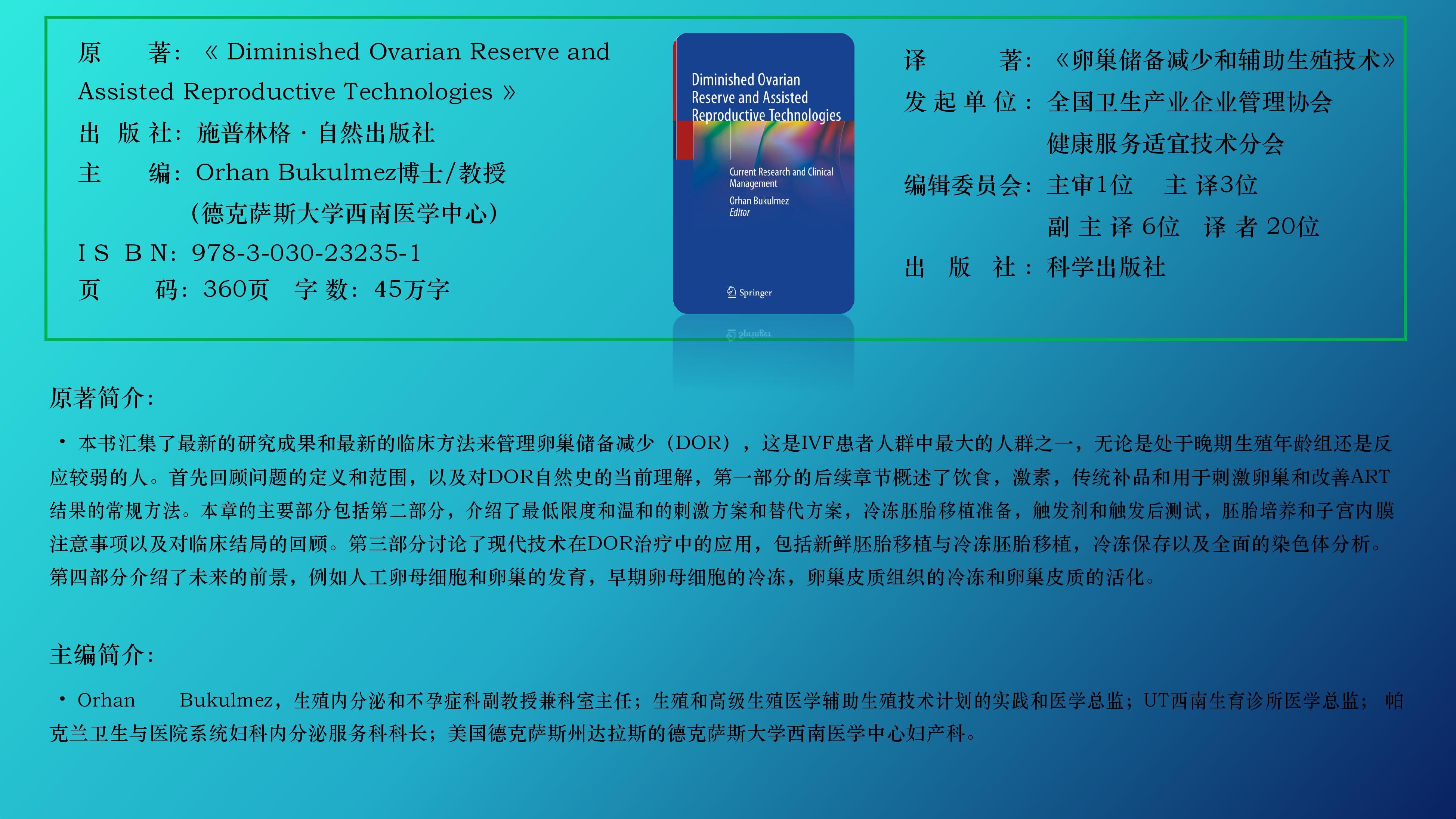系列丛书
当前位置:首页 > 系列丛书

原 著:《 Diminished Ovarian Reserve and Assisted Reproductive Technologies 》
译 著:《卵巢储备减少和辅助生殖技术》
This book brings together the most current research and the latest clinical approaches to the management of diminished ovarian reserve (DOR), one of the largest segments of the IVF patient population, both in the advanced reproductive age group as well as poor responders. Opening with a review of the definition and scope of the problem, as well as the current understanding of the natural history of DOR, subsequent chapters in part I outline dietary, hormonal, traditional supplements and conventional methods used to stimulate ovaries and improve ART outcomes. The main segment of chapters, comprising part II, present minimal and mild stimulation protocols and alternatives, frozen embryo transfer preparation, trigger agents and post-trigger testing, embryo culture and endometrial considerations, and a review of clinical outcomes. Part III discusses the utilization of contemporary technologies in the treatment of DOR, including fresh vs. frozen embryo transfer, cryopreservation and comprehensive chromosomal analysis. Future prospects are presented in part IV, such as the artificial oocyte and ovary development, early-age oocyte freezing, ovarian cortical tissue freezing and activation of the ovarian cortex.
Utilizing the latest evidence and authored by an international array of thought leaders, Diminished Ovarian Reserve and Assisted Reproductive Technologies is an excellent resource for reproductive medicine and REI specialists, IVF lab professionals, and students and residents in these areas.
1. Introduction: The Scope of the Problem with Diminished Ovarian Reserve
2. Ovarian and Hypothalamic Aging
3. Natural History of Diminished Ovarian Reserve
4. Definitions and Relevance: Diminished Ovarian Reserve, Poor Ovarian Response, Advanced Reproductive Age, and Premature Ovarian Insufficiency
5. Food Supplements and Hormonal Products to Improve Assisted Reproductive Technology Outcomes in Patients with Diminished Ovarian Reserve
6. Traditional Chinese Medicine for Assisted Reproductive Technology
7. Controlled Ovarian Stimulation Protocols for IVF: From First IVF Baby in the United States and Beyond
8. Conventional Controlled Ovarian Stimulation Protocols for Diminished Ovarian Reserve Patients and Poor Responders
9. Natural Cycle Approaches for ART
10. The International Society for Mild Approaches in Assisted Reproduction (ISMAAR) Definitions for Mild Stimulation and Their Rationale for Assisted Reproductive Technologies
11. Current Outlook of Minimal and Mild Stimulation Protocols for Assisted Reproductive Technologies in Women with Diminished Ovarian Reserve and/or Advanced Reproductive Age
12. Minimal Stimulation Protocol for Assisted Reproductive Technologies in Women with Diminished Ovarian Reserve and/or Advanced Reproductive Age
13. Mild Stimulation Alternatives to Minimal Stimulation
14. Control of Luteinizing Hormone (LH)
15. Preventing Premature Ovulation
16. Trigger Agents and Post-trigger Testing
17. Oocyte Retrieval
18. Fertilization: Conventional IVF Versus ICSI
19. Embryo Culture: Cleavage Versus Blastocyst Stage
20. Endometrial Considerations for Minimal Stimulation
21. Frozen Embryo Transfer Preparation
22. Minimal and Mild Stimulation IVF Results
23. Fresh Versus Frozen Embryo Transfer
24. Comprehensive Chromosome Analysis in Diminished Ovarian Reserve Patients
25. Artificial Oocyte and Artificial Ovary Development
26. Activation of Ovarian Cortex
27. Oocyte Cryopreservation at an Earlier Age
28. Ovarian Cortical Tissue Biopsy and Freezing for Autotransplantation

